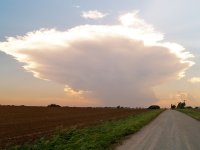Atmospher Sci & Global Chg
Research Highlights
May 2012
Pollution + Storm Clouds = Warmer Atmosphere
Computer modeling reveals new insights on interactions between pollution particles and storms

An anvil cloud looms over the Southern Great Plains site location of the U.S. Department of Energy’s Atmospheric Radiation Measurements (ARM) Climate Research Facility. Enlarge Image
Results: For the first time, researchers at Pacific Northwest National Laboratory have shown that pollution increases warming in the atmosphere through enlarging thunderstorm clouds. The scientists conducted a computational study with resolutions high enough to allow the team to see the clouds develop. They found that for warm summer thunderstorms, pollution particles lead to stronger storms with larger, anvil-shaped clouds, which also last longer. The warming effect dominated by trapping more heat, especially at night, even though these larger clouds also reflected more daytime sunlight warmth back into space.
Why it Matters: Clouds are one of the most poorly understood components of the Earth's climate system. Getting a better understanding of clouds, and how atmospheric particles affect them, is important to better predict the future of climate change.
"Global climate models don't see this effect because thunderstorm clouds simulated in those models do not include enough detail," said Dr. Jiwen Fan, lead author and a scientist at PNNL. "The large amount of heat trapped by the pollution-enhanced clouds could potentially impact regional circulation and modify weather systems."
For more information, see the PNNL News Center, "Pollution teams with thunderclouds to warm atmosphere."
Acknowledgments: This study was supported by the U.S. Department of Energy's (DOE) Office of Science and Biological and Environmental Research (BER) Regional & Global Climate Modeling (RGCM) Program as part of a bilateral agreement with the China Ministry of Sciences and Technology on regional climate research and the U.S. DOE BER's Atmospheric System Research (ASR) Program . The work was performed by Drs. Jiwen Fan and L. Ruby Leung of PNNL; Dr. Daniel Rosenfeld of The Hebrew University of Jerusalem; Dr. Zhanqing Li and Yanni Ding of the University of Maryland.
Reference: Fan J, D Rosenfeld, Y Ding, LR Leung, and Z Li. 2012. "Potential Aerosol Indirect Effects on Atmospheric Circulation and Radiative Forcing through Deep Convection." Geophysical Research Letters 39:L09806. DOI:10.1029/2012GL051851.
